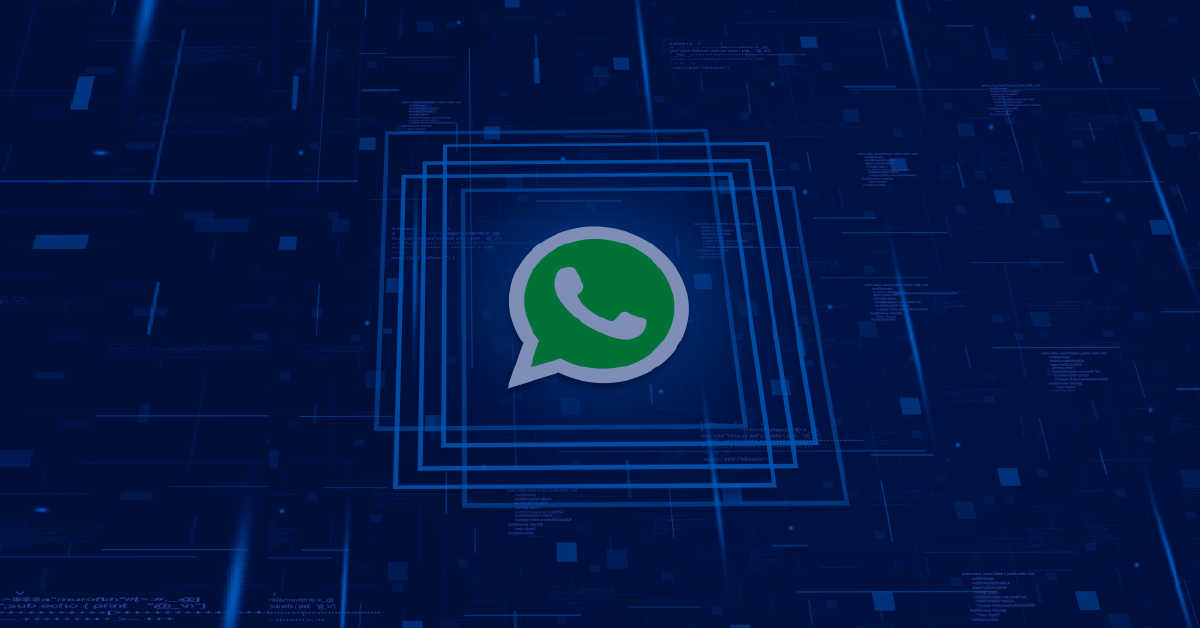In a world where information is at our fingertips and communication happens in real-time, people have grown accustomed to immediacy. Social media, messaging apps, and on-demand services have conditioned individuals to expect rapid replies.
The demand for swift, efficient communication has elevated beyond a mere preference, it has become a defining factor setting businesses apart in a competitive landscape.
A study by HubSpot found that 82% of customers expect a quick response, in under 10 minutes, from businesses on messaging apps.
That is a tall order to fill.
This is where WhatsApp automation comes in.
WhatsApp, the most popular global messaging application with over 2.78 billion active users and automation functionalities, is one of the most preferred marketing channels.
As businesses strive to connect with their audience in real-time, WhatsApp Automation emerges as a gamechanger.
This comprehensive guide aims to navigate the intricate world of WhatsApp automation, unraveling its benefits, use cases and the ways it can be leveraged to drive business growth.
What is WhatsApp Automation?
WhatsApp Automation is the strategic use of tools or programming to automate tasks and interactions within the messaging platform.
One key aspect involves predefined message templates—formatted texts designed for specific scenarios.
With predefined message templates, businesses can quickly send standardized messages for common scenarios.
Additionally, trigger-based automation enables specific actions or messages to be carried out when certain conditions are met, making interactions more efficient and personalized.
From sending automated messages to handling customer queries efficiently, this transformative tool empowers businesses to save time and resources while fostering meaningful connections.
It aims to optimize various actions on the platform, enhancing efficiency and user experience.
Benefits of WhatsApp Automation
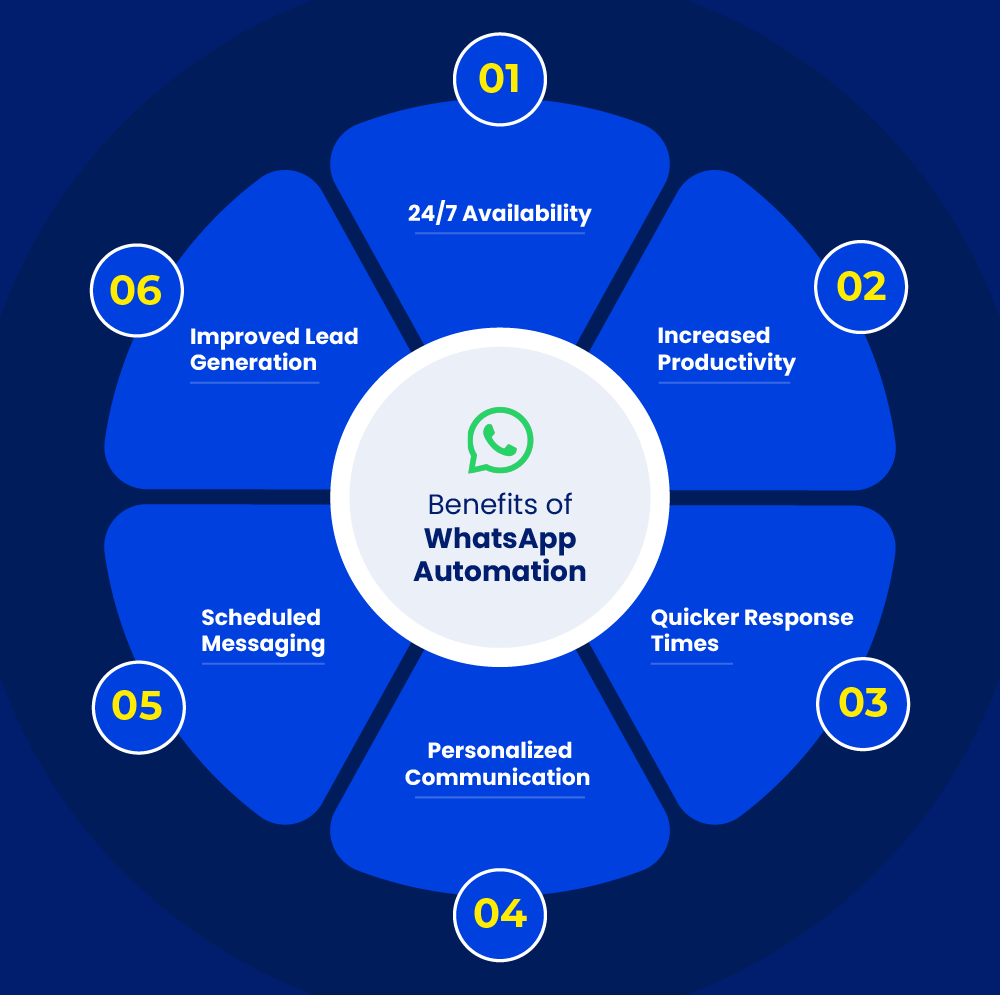
1. 24/7 availability
Helps businesses maintain continuous interaction with users and offer support irrespective of the time.
2. Increased productivity
Reduces manual effort, allowing businesses to efficiently manage a high volume of queries and tasks.
3. Quicker response times
Chatbots enable businesses to provide immediate answers to FAQs, creating a seamless and responsive user experience.
4. Personalized communication
WhatsApp automation tools leverage user data to craft personalized messages and enhance user engagement.
5. Scheduled messaging
This feature ensures timely communication, allowing for strategic outreach during peak times or specific events.
6. Improved lead generation
Automation facilitates lead generation by employing interactive forms, qualification surveys, and automated follow-up sequences.
Now let’s dive into the varied use cases of WhatsApp automation and explore the unique ways you can leverage it to streamline operations.
15 Use Cases of WhatsApp Automation
WhatsApp automation can be used in many ways to improve specific business processes and boost customer engagement.
Here are 15 ways you can implement it for your business:
1. Instant order confirmations and updates
Build trust and loyalty by providing real-time order updates, enhancing the post-purchase experience and keeping customers informed throughout the order lifecycle.
How:
- API Connectivity: Connect your e-commerce platform with WhatsApp API for real-time order updates.
- Status Triggers: Define triggers for different order statuses to automate the sending of confirmation messages and updates to customers.
Example: Online retailers can leverage WhatsApp for real-time updates on high-demand product releases. This could involve providing customers with instant order confirmations, shipping details, and live tracking links during product launches.
2. Efficient appointment scheduling
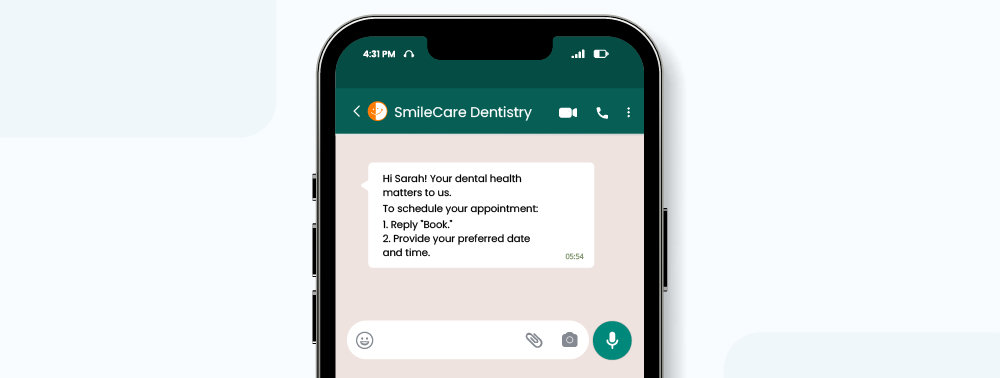
Enhance customer experience by simplifying the appointment booking process, reducing no-shows through automated reminders, and optimizing resource allocation.
How:
- Calendar Integration: Integrate your appointment scheduling system with WhatsApp to allow customers to book appointments directly.
- Automated Reminders: Set up automated reminders using WhatsApp to reduce no-shows and improve overall scheduling efficiency.
Example: A medical clinic can optimize its appointment scheduling process by integrating WhatsApp. This could enable patients to book slots for specialized services like flu vaccinations, while automated reminders could be sent a day before to reduce no-shows.
3. Automated customer service responses
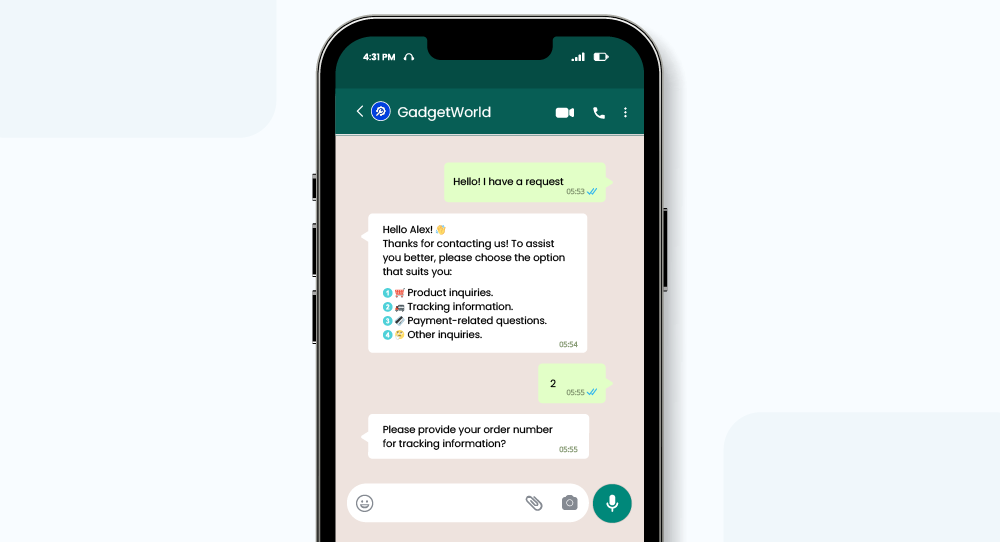
Improve customer satisfaction by providing instant responses, resolving common issues efficiently, and freeing up human agents to handle more complex queries.
How:
- Chatbot Integration: Deploy a chatbot on WhatsApp using the WhatsApp Business API, programmed to understand and respond to common customer queries.
- Natural Language Processing: Implement Natural Language Processing (NLP) capabilities in the chatbot to enhance its understanding of user inquiries.
Example: A telecommunications company can enhance customer support by considering the deployment of a WhatsApp chatbot, capable of swiftly addressing specific customer inquiries during peak times, such as troubleshooting network issues or assisting with billing discrepancies.
4. Personalized marketing campaigns
Increase engagement and conversion rates by delivering targeted and personalized marketing messages, aligning with customer preferences and behaviors.
How:
- Customer Segmentation: Utilize customer data to create targeted segments based on demographics, behavior, or preferences.
- Dynamic Content: Craft personalized and dynamic content that resonates with each segment, ensuring relevance in marketing messages.
Example: Retail stores can explore using WhatsApp to deliver personalized promotions during flash sales. Dynamic content, including exclusive offers on trending items, could be tailored to specific customer segments like frequent buyers and those who recently viewed specific product categories.
5. Lead qualification and follow-up
Streamline lead qualification, ensure timely engagement with high-potential leads, and optimize sales team productivity.
How:
- Employ a WhatsApp CRM, like LeadSquared.
- Design automated lead qualification questions to be sent via WhatsApp.
- Implement a system that categorizes responses based on predefined criteria.
- Use automation rules to route promising leads to the sales team for immediate follow-up.
Example: Businesses can utilize WhatsApp to automate the lead qualification process. By posing qualifying questions through automated messages, the responses can be categorized using predefined criteria. High-potential leads can then be seamlessly routed to the sales team for immediate and targeted follow-up, improving overall efficiency in the sales process.
6. Strategic Lead Nurturing Sequences
Increase conversion rates by nurturing leads at various stages of the sales funnel, providing relevant content and maintaining engagement.
How:
- CRM Workflow Automation: Leverage CRM workflows to automate lead nurturing sequences based on user interactions.
- Scoring Systems: Implement lead scoring systems to prioritize and tailor messaging based on the prospect’s level of engagement.
Example: Companies can explore the use of WhatsApp to nurture leads during a product launch. The potential lies in leveraging CRM workflows to automatically deliver targeted content, such as interactive product demos, based on user interactions to guide leads through the sales funnel.
7. Abandoned cart recovery
Increase cart recovery rates, personalize incentives, and minimize revenue loss due to abandoned carts.
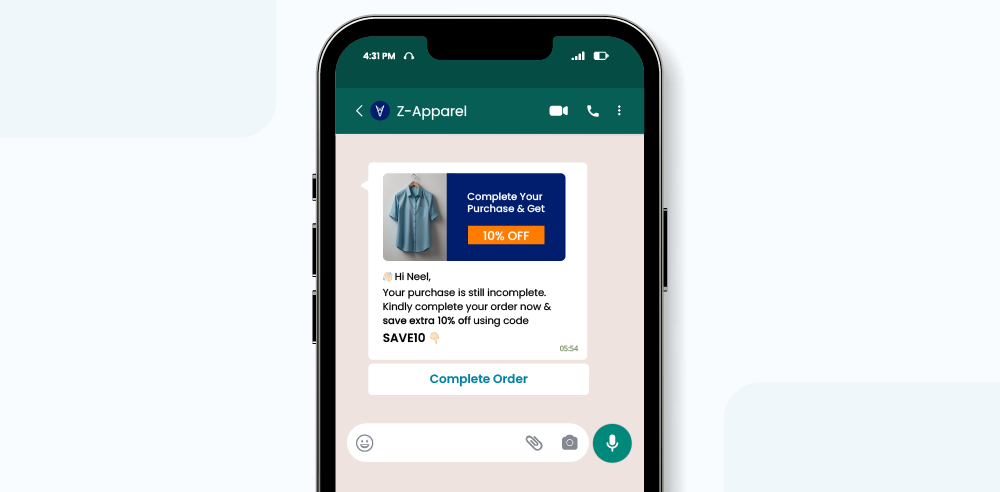
How:
- Utilize an e-commerce platform that supports WhatsApp integration.
- Implement an abandoned cart recovery system that triggers automated messages on WhatsApp after a predefined time.
- Personalize messages with details of the abandoned items and offer incentives like discounts or limited-time promotions.
Example: E-commerce businesses can deploy WhatsApp to automatically send reminders to users who left items in their shopping carts. Through personalized messages and incentives, such as limited-time discounts, businesses can boost the likelihood of users completing their purchases.
8. Invoice and payment reminders
Improve cash flow, reduce late payments, and offer a convenient payment process for customers.
How:
- Integrate a billing and invoicing system with WhatsApp Business API.
- Automatically generate and send invoices through WhatsApp to customers.
- Set up automated reminders for upcoming or overdue payments with clear instructions for payment.
Example: Service providers, such as freelancers or small businesses, can utilize WhatsApp to send invoices and automated payment reminders. This ensures a seamless and efficient payment process, reducing delays and improving overall cash flow.
9. Feedback collection
Gather valuable insights, measure customer satisfaction, and identify areas for improvement in products or services.
How:
- Integrate a survey or feedback collection tool with WhatsApp Business API.
- Schedule automated messages after specific customer interactions or purchases, requesting feedback.
- Implement a chatbot to engage with customers, collect responses, and provide instant acknowledgments.
Example: After a customer makes a purchase, an online retailer can automate a WhatsApp message asking for feedback. A chatbot can then engage with the customer, collecting insights on their experience and preferences to enhance future interactions.
10. Emergency notifications and alerts
Enable quick information dissemination, maintain transparency during emergencies, and provide two-way communication for support.
How:
- Automation: Use WhatsApp for automated emergency notifications and alerts, ensuring timely communication during critical situations such as server downtimes or security breaches.
Example: A technology company can employ WhatsApp for automated notifications during server downtimes. This ensures that clients receive instant alerts, and the two-way communication feature allows them to seek support or clarification immediately.
11. Feedback collection and surveys
Gather valuable insights for continuous improvement, make data-driven decisions, and demonstrate a commitment to meeting customer expectations.
How:
- Integrated Survey Platforms: Use survey platforms that integrate seamlessly with WhatsApp Business API.
- Automated Survey Distribution: Schedule automated survey distributions based on customer interactions or specific touchpoints.
Example: A hospitality business can consider using WhatsApp to gather post-stay feedback. Automated surveys could be distributed based on guest interactions, providing valuable insights to enhance the overall guest experience.
12. Internal team communication
Foster a collaborative work environment, ensure timely information dissemination, and improve overall team efficiency by automating internal communication.
How:
- Collaboration Tools Integration: Integrate collaboration tools with WhatsApp for a cohesive internal communication system.
- Channel Management: Implement channels for different teams or projects, streamlining communication and ensuring relevant updates reach the right recipients.
Example: A software development firm has the potential to enhance project-based communication by integrating collaboration tools with WhatsApp. This could involve setting up channels for different development projects, streamlining communication, file sharing, and progress updates among team members.
13. Efficient employee onboarding paths
Accelerate the onboarding process, enhance the new hire experience, and ensure employees have the necessary information for a productive start.
How:
- Learning Management System Integration: Integrate your Learning Management System (LMS) with WhatsApp for automated content delivery.
- Onboarding Flowcharts: Design clear onboarding flowcharts, automating steps such as document submissions and training module releases.
Example: HR departments can streamline employee onboarding by integrating their Learning Management System with WhatsApp. New hires could receive automated onboarding messages and resources, including a clear path for document submissions and access to training modules.
14. Seamless event coordination
Simplify event coordination, improve attendee experience, and ensure effective communication from invitations to post-event updates.
How:
- Event Management Software: Use event management software with WhatsApp integration to streamline communication.
- Automated Guest List Management: Automate guest list updates, sending personalized invitations and event details through WhatsApp.
Example: An event planning agency can utilize event management software with WhatsApp integration for a corporate networking event. Automated guest list management ensures personalized invitations, and real-time event updates are sent, enhancing attendee engagement and satisfaction.
15. Interactive polls for decision-making
Facilitate agile decision-making by gathering quick feedback, ensuring inclusivity, and making informed decisions based on real-time input.
How:
- Polling Platform Integration: Integrate interactive polling platforms with WhatsApp Business API.
- Decision Workflow: Establish workflows for immediate action based on poll results, ensuring a swift and responsive decision-making process.
Example: If you are organizing a product launch webinar, you can leverage interactive polls through WhatsApp. By integrating a polling platform, the team can gauge audience preferences in real-time, allowing them to tailor the presentation to focus on the features or aspects that generate the most interest.
This immediate feedback can guide your decisions on marketing strategies and product positioning.
It is crucial to understand which automation platform is best suited to help you achieve the use-cases you need.
WhatsApp Automation Platforms
As businesses embark on the journey of WhatsApp Automation, understanding the available platforms is crucial.
WhatsApp Business and WhatsApp Business API stand out as primary players in this arena, each offering distinct functionalities and capabilities.
WhatsApp Business is an accessible entry point for smaller scale automation.
Its user-friendly interface makes it an ideal choice for businesses looking to initiate automation without the need for extensive technical knowhow.
However, it’s essential to be aware of its limitations, particularly for enterprises with growing automation needs.
WhatsApp Business API, on the other hand, caters to businesses with more advanced requirements.
It provides a more robust framework, allowing for a deeper integration of automation processes.
Here’s a table that compares WhatsApp Business and WhatsApp Business API so you can choose which platform is better suited to your requirements.
WhatsApp business vs. WhatsApp business API
Automation Feature | WhatsApp Business | WhatsApp Business API |
Quick Replies | Limited use of predefined responses to common queries | Full support for creating custom quick replies tailored to specific business needs |
Message Triggers | Limited to user-initiated conversations | Can initiate conversations based on predefined triggers, allowing proactive engagement |
Away Messages | Basic away messages for when the business is unavailable | Advanced away messages with the ability to provide detailed information and instructions |
Chatbots | Limited capabilities to build simple chatbots | Complete integration with sophisticated chatbots for complex interactions and personalized responses |
Interactive Buttons | Basic support for static buttons in messages | Dynamic and customizable buttons for interactive user experiences within the chat |
Media Message Automation | Foundational capabilities for sending images and documents | Advanced media message automation, including the ability to send rich media such as audio, video, and documents |
Workflow Integration | Limited integration with external systems | Seamless integration with various business workflows and third-party applications |
Dynamic Content | Limited ability to personalize messages with dynamic content | Extensive support for dynamic content to create highly personalized and relevant messages |
Now, let’s delve into the process of setting up WhatsApp automation.
Setting up WhatsApp Automation
The initial setup of WhatsApp automation is a critical step that lays the foundation for seamless integration into existing processes.
While the specific steps may vary depending on the chosen platform, here is a general overview to guide businesses through the setup process:
1. Create a WhatsApp Business Account: Begin by setting up a dedicated business account on WhatsApp. This ensures a professional presence and access to business centric features.
2. Download and install WhatsApp Business App: For businesses opting for the WhatsApp Business App, download and install the application on the desired device. Follow the onscreen instructions to set up the business profile.
3. Verify your business: WhatsApp often requires businesses to go through a verification process to ensure authenticity. This step adds a layer of credibility to your business profile.
4. Explore automation settings: Once the business account is set up, navigate to the automation settings. Here, businesses can configure automated responses, greetings, and frequently asked questions.
5. Test automation workflows: Before deploying automation at scale, it’s crucial to test the workflows. Send test messages, simulate customer interactions, and ensure that the automated responses align with the desired outcomes.
6. Integrate with CRM systems: Integrating WhatsApp with existing Customer Relationship Management (CRM) systems is key for businesses seeking to elevate their automation capabilities. This ensures a centralized view of customer interactions and seamless data flow between platforms.
By following these steps, businesses can establish a solid foundation for WhatsApp automation, setting the stage for enhanced communication and operational efficiency.
Now, let’s explore various scenarios where WhatsApp automation proves invaluable for businesses, showcasing its versatility and practical applications in enhancing communication and operational efficiency.
Features of WhatsApp Automation
Understanding the features that WhatsApp automation brings to the table is pivotal for businesses to make the most of this transformative technology.
Here’s a breakdown of available features:
1. Message automation: You can set up WhatsApp to send messages automatically when specific conditions are met.
For example, a retail store can automatically greet new members joining their loyalty program on WhatsApp, enhancing the onboarding experience.
2. Broadcasts: This feature lets you send the same message to many contacts at the same time, making it efficient for spreading information widely.
For example, an event organizer can efficiently inform attendees about last-minute changes or updates by sending broadcast messages to all participants simultaneously.
3. Auto replies: You can program WhatsApp to respond automatically to certain words or messages.
For example, a customer service team can set up auto-replies on WhatsApp to promptly acknowledge customer compliments or feedback, enhancing engagement.
4. Message sequences: This allows you to create a series of messages that are sent in a specific order.
For example, a digital banking platform employs WhatsApp message sequences to facilitate customer onboarding. The automated series guides new customers through account setup, security verification, and introduces essential features. This personalized onboarding journey enhances the customer experience, providing valuable information in a structured and user-friendly manner.
5. Contact management: Automation can help organize your contacts, add or remove them based on predefined criteria, making it easier to handle large contact lists.
For example, an e-commerce platform can use automation to manage customer contacts, adding them to specific lists such as frequent shoppers, impulsive buyers etc. based on their purchase history or preferences.
6. Data extraction: Automation tools can pull out important information from messages or group chats, making it quicker to gather specific details.
For example, a market researcher can employ automation tools to extract valuable insights from customer messages, streamlining the process of data collection.
7. Integration with APIs: Connecting WhatsApp automation with APIs streamlines business communication by centralizing channels, synchronizing data seamlessly across systems like CRM and marketing platforms. This integration enhances workflows, automates processes, and provides unified customer insights, fostering a personalized and resource-efficient operational experience.
For example, syncing WhatsApp automation with a CRM system in e-commerce ensures smooth customer data updates. Post-purchase, automated order confirmations via WhatsApp offer real-time updates, enhancing both operational efficiency and customer communication.
8. Analytics: You can track and analyze how well your automated messages are performing in terms of engagement and overall effectiveness.
For example, a marketing team can use analytics to track the performance of automated messages, refining their strategy based on engagement metrics.
9. Multi-channel integration: This involves coordinating your WhatsApp automation with other communication channels like email or social media for a more cohesive communication strategy.
For example, businesses can utilize WhatsApp for quick updates or time-sensitive messages, while employing email for more detailed communications or newsletters. By connecting these channels, businesses ensure a seamless and versatile outreach, adapting to diverse customer preferences and needs.
10. Appointment scheduling: Automation can enable users to schedule appointments or set reminders through WhatsApp, streamlining the process of planning and organizing.
For example, a healthcare provider can streamline appointment scheduling by allowing patients to book appointments or receive reminders through WhatsApp, improving overall patient experience.
However, it’s important to use these features responsibly, respecting privacy rules and following WhatsApp’s terms of service to avoid any potential problems or violations.
By integrating WhatsApp into your CRM, you can employ targeted WhatsApp automation to nurture leads, personalize marketing efforts, and drive sales, thereby directly contributing to increased revenue and business growth. Read on to learn how you can integrate WhatsApp into your CRM.
Integrating WhatsApp Automation into your CRM
By integrating WhatsApp with your CRM, you can centralize communication channels, fostering a cohesive customer experience.
It simplifies data flow, enabling timely responses and informed interactions that contribute to improved overall customer satisfaction.
This is how you can integrate WhatsApp into your CRM:
1. CRM system compatibility check
Ensure your CRM system supports API integrations and has the necessary customization capabilities.
Steps:
- Go to your CRM system settings.
- Confirm if it supports secure data transfer (HTTPS).
- Check if you can control API access permissions for different users.
- Ensure the CRM can handle real-time events from WhatsApp effectively.
2. Message template creation
Create WhatsApp message templates according to WhatsApp guidelines and submit them for approval.
Steps:
- Visit the WhatsApp Business API portal.
- Follow WhatsApp’s guide to create message templates.
- Submit them for approval and keep track of the status.
- Once approved, add the templates to your CRM.
The approval process may take around 24-48 hours.
3. Use WhatsApp templates
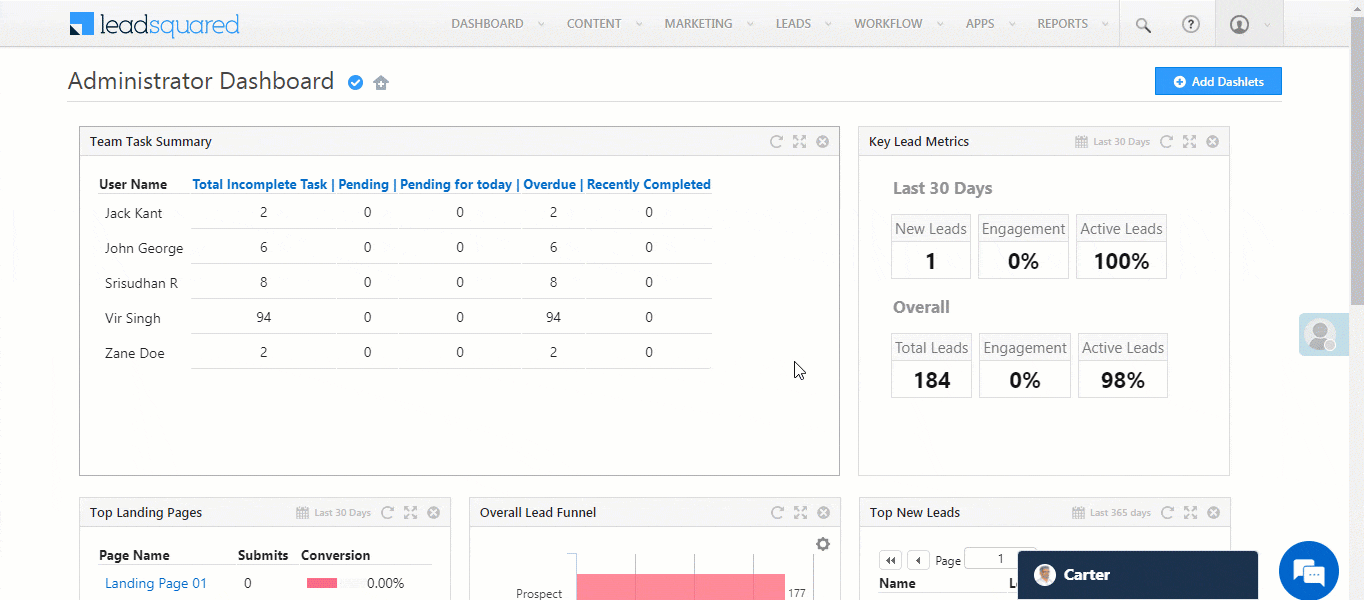
Steps:
- Integrate Template IDs dynamically, mapping CRM data fields to template variables.
- Ensure your CRM allows for easy management and version control of templates.
You can use these templates as part of your automated workflows or manually initiated communications.
4. Webhooks for real-time notifications
Set up webhooks to receive real-time notifications from WhatsApp, such as message status updates.
Steps:
- In your CRM, look for webhook settings.
- Set up a webhook with the endpoint for WhatsApp notifications.
- Configure your CRM to respond to real-time updates from WhatsApp.
- Test to ensure your CRM reacts appropriately to these notifications.
5. Workflow configuration
Within your CRM system, configure workflows or automation rules to trigger actions based on specific events, such as lead creation or status changes.
Steps:
- Access your CRM’s workflow settings.
- Create new workflows based on your business processes.
- Add WhatsApp actions into these workflows using CRM events as triggers.
- Test these workflows to make sure WhatsApp actions integrate smoothly.
6. Automation triggers
Define triggers within your CRM that initiate WhatsApp actions, such as sending messages, when certain conditions are met (e.g., new lead creation, lead qualification).
Steps:
- Identify specific events in your CRM that should trigger WhatsApp actions.
- Configure triggers in your CRM’s automation settings.
- Set conditions for these triggers to activate, considering lead scoring or historical data.
- Validate triggers by testing with real and simulated scenarios.
7. API call integration
Integrate API calls into your CRM’s workflow logic to initiate communication through the WhatsApp Business API at specific points in the customer journey.
Steps:
- Go to your CRM’s API integration section.
- Use API calls to initiate WhatsApp actions within your CRM workflows.
- Ensure secure authentication with WhatsApp Business API.
- Optimize API calls for efficiency.
8. Conditional messaging
Implement conditional logic in your automations to send personalized and context-specific messages based on lead attributes, status, or interactions.
Steps:
- Within your CRM’s automation rules, add conditions for WhatsApp messages.
- Use CRM features for natural language processing to enhance the content.
- Test messaging under various user scenarios.
9. Dynamic content integration
Utilize dynamic content capabilities within your CRM system to customize WhatsApp messages dynamically, pulling information from lead records.
Steps:
- Explore your CRM’s dynamic content capabilities.
- Add dynamic content elements into WhatsApp messages.
- Confirm your CRM can pull real-time data into these dynamic elements.
10. Event-based messaging
Set up event-based triggers to send automated messages on specific occasions, such as birthdays, anniversaries, or other milestones stored in your CRM.
Steps:
- Set up event triggers in your CRM for specific occasions.
- Configure your CRM to recognize these events.
- Create automated WhatsApp messages for each event.
- Test the system with sample data to ensure event-based triggers work.
11. Testing automation rules
Thoroughly test your automation rules to ensure they trigger the intended WhatsApp actions accurately and at the right points in the customer lifecycle.
Steps:
- Use your CRM’s testing environment for controlled scenarios.
- Conduct A/B testing within your CRM workflows.
- Monitor user responses and adjust your approach based on testing outcomes.
12. Error handling
Implement error-handling mechanisms within your CRM’s automation rules to manage situations where WhatsApp messages may fail to send.
Steps:
- Enable error logging in your CRM for WhatsApp actions.
- Set up alerts for critical errors to ensure prompt responses.
- Use any built-in anomaly detection features in your CRM for early issue identification.
13. User opt-in and opt-out management
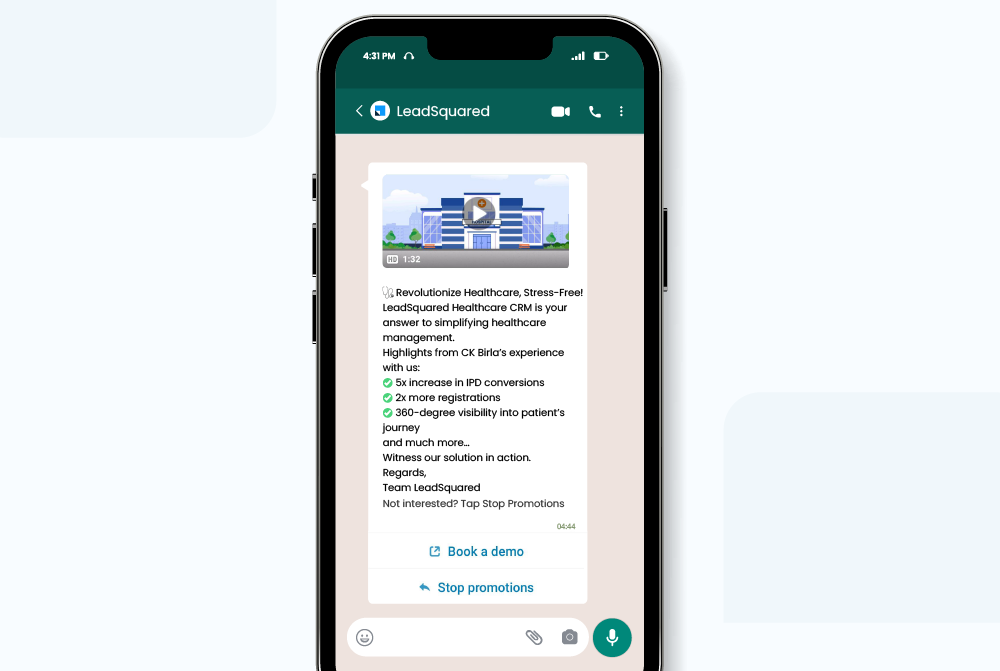
Integrate features in your automations to manage user opt-ins and opt-outs, ensuring compliance with WhatsApp policies.
Steps:
- Add a double opt-in process within your CRM for user consent.
- Utilize CRM features for user preference centers.
- Ensure compliance with WhatsApp policies on user communication preferences.
14. Feedback loops
Implement feedback loops within your CRM to capture and analyze user interactions with WhatsApp messages, allowing for continuous improvement of automated communication.
Steps:
- Use sentiment analysis tools if available in your CRM.
- Integrate feedback surveys directly into WhatsApp messages.
- Analyze responses to refine your automated communication.
15. Scalability planning
Design your integration to be scalable, considering potential growth in data volume and user interactions.
Steps:
- Assess your CRM’s scalability features.
- Configure autoscaling options for resource allocation.
- Implement strategies like sharding for distributed data storage.
- Regularly review capacity planning for future scaling needs.
Integrating WhatsApp into your CRM streamlines communication, offering a consolidated view for efficient customer management and personalized engagement.
This integration enhances operational efficiency, fostering stronger customer relationships.
Conclusion
Unlocking the potential of WhatsApp automation empowers businesses to meet customer expectations and create tailored experiences, driving engagement and operational efficiency.
LeadSquared’s user-friendly platform, featuring dynamic content integration, scalability planning, and seamless CRM integration, enables businesses to customize their automation strategies and scale them as they grow.
With LeadSquared’s Converse, you can seamlessly navigate WhatsApp chats within our platform, automatically storing all shared chats and documents in the lead’s profile.
Additionally, you can efficiently assign chats to agents based on their availability through automation.
Navigating WhatsApp automation intricacies, optimizing workflows, and fostering meaningful customer connections is made easy with LeadSquared . Curious about how it works?
FAQs
To create a WhatsApp chatbot, start by defining specific objectives tailored for WhatsApp.
1. Choose a platform supporting WhatsApp Business API integration.
2. Design a conversational flow optimized for WhatsApp users.
3. Integrate your chatbot with the WhatsApp API, ensuring compliance with guidelines.
4. Thoroughly test within the WhatsApp environment, collecting feedback and iterating for a positive user experience.
WhatsApp chatbot pricing varies by model. WhatsApp Business is free for small businesses while WhatsApp Business API and WhatsApp Cloud API have conversation-based pricing.
User-initiated conversations incur charges for the first message, while the first 1,000 conversations per month are free. WhatsApp Cloud API, hosted on Meta’s servers, incurs no additional hosting charges.







